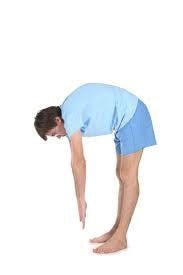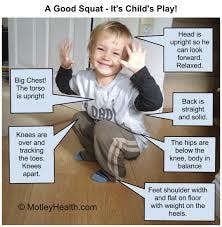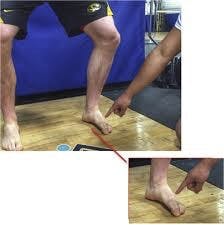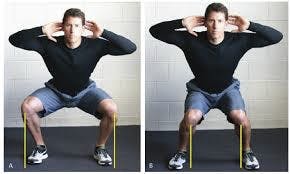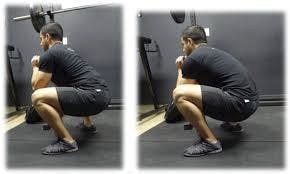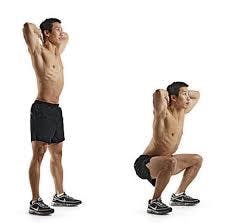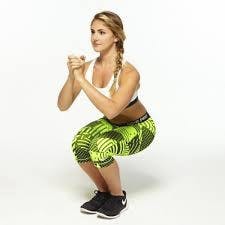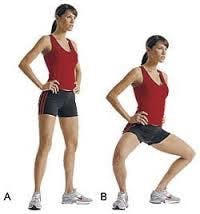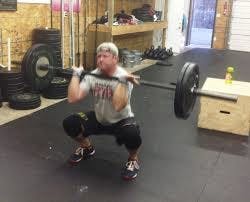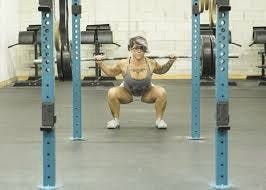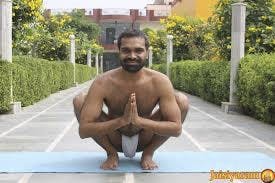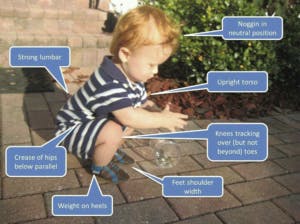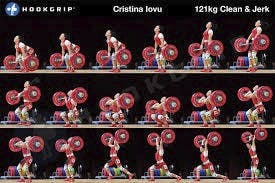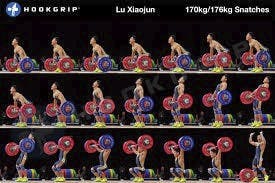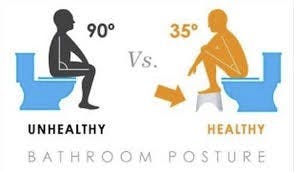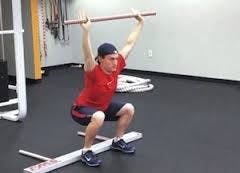This is the final installment of the squat series, where we will discuss the myriad of ways you can incorporate squatting into your workout. In part one we discussed the many health benefits that simply squatting provides throughout the day. In part two we discussed some of the fine nuances of form that make a proper squat and those that are detrimental in terms of poor form. As we discuss the various ways that you can incorporate squatting into your workouts, remember that you are in charge of your body and how it works. Many of the squats that we will discuss will be fine for a person to perform if they own perfect movement mechanics but for someone who is movement challenged these squats may very well aggravate your system.
I will breakdown the squatting by starting with the least challenging or the least functional squatting and then slowly progress to the most challenging and the most functional. Notice that I lumped the words challenging and functional together which was done on purpose. Typically, but not always, a movement that is very challenging to perform also has a high correlation to function. Full body movements that are challenging to the central nervous system are such that the exercise becomes self limiting. Mindless repetitions cannot be performed and these self limiting exercises seem to help asymmetries, movement pattern problems and minimize the chance of incurring a repetitive trauma type injury. Are you ready??? Here we go.
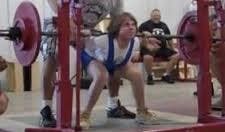
The barbell back squat has been around since man invented the barbell. This type of squat is the least functional for a number of reasons. The first being – what type of daily activities do you perform where you have a load on your back and you repetitively squat up and down. Rarely if ever. The second issue is that with the back squat you can have absolutely horrible form and still complete the squat which of course is a bad idea to continue this habit. Second, because the bar is on your back you can perform this type of squat with fairly heavy loads and again still complete the movement which will place unnecessary stress on your spine. Third, because you can lean forward with the weight on your back, you increase the lever arm on your spine which ramps up the stress on the lower lumbar discs and, again, place unnecessary loads on the spine. Many traditional athletes and coaches still swear by this type of squat as being the holy grail of training but in recent years we have seen many new age coaches understand the limited carryover of this type of squat to actually improving their athletes performance on the field. I should mention that the picture that I choose above displays horrible form yet the squatter was probably successful in lifting the weight. Personally, I would never encourage anyone to perform this type of squat.
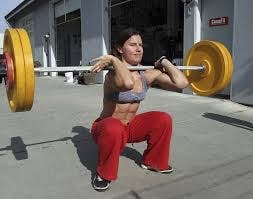
The barbell front squat is a common exercise to those who know the Olympic lifts. It is a much more challenging exercise than the barbell back squat and for many reasons a much more functional exercise. First by the nature of having the barbell across the front of the shoulders and resting on the fingers much less weight can be used than during the barbell back squat. Since less weight can be used during this squat, there is less strain on the lower back and that is always a plus. Second, because the weight of the barbell is resting on the shoulders and fingers the spine or trunk must be upright and if the trunk starts to lean forward you are surely going to drop the weight forward. The fact that the spine/trunk must stay very upright also places less strain on the lower back. Third, because the shoulders, elbows, wrists and fingers are stretched to maintain the front rack position this helps maintain a level of flexibility in these joints that is not stressed in the barbell back squat. This exercise has more carryover to daily activities then the barbell back squat. I recommend this type of squat even for beginners.
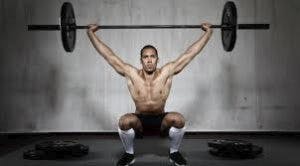
The king of barbell squat exercises. This exercise is the most challenging barbell squat exercise because the arms are now holding the entire weight of the barbell in an overhead press position. This type of squat demands maximum thoracic extension, scapula mobility and shoulder stability. Plus while the thoracic spine is staying in extension the lumbar spine is slightly flexing at the bottom of the squat requiring a high level of core flexibility and stability. This type of squat demands thought while you are performing the exercise so it is very central nervous system (CNS) intensive. You can not perform mindless reps of this exercise while watching the TV at the gym, the overhead barbell squat requires total focus. When you become proficient in performing this exercise with heavy weight, normal daily activities will seem like a breeze. This exercise will also carry over into improving other functional activities such as sprinting and jumping. I recommend this type of squat for intermediate level lifters.
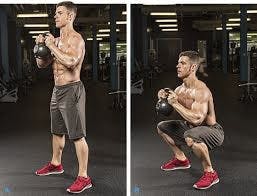
The Goblet Squat is probably the most functional dumbbell or kettle bell based squat. Look at the position of the kettle bell, it is exactly in the same position you would be carrying an item that you needed to squat down to the floor with. While the overhead barbell squat requires more coordination, flexibility and stability, the goblet squat more closely resembles a daily activity therefore has more carryover to enhancing a movement you are more apt to perform. That is what training is all about. Proper form in the goblet squat allows an upright trunk which stays in neutral allowing the hips, knees and ankles to perform all the motion. This is congruent with the principles we discussed in the Squat Part 2. If you have never squatted before as an exercise this is probably the best introductory weighted squat for you to incorporate in your training. I highly recommend this type of squat even for those who have never lifted a weight before in their life.
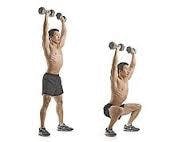
The Dumbbell Overhead Squat is another variation of the overhead squat. Obviously holding separate weights in each hand instead of a bar places more challenge and demand on this exercise and that is a good thing. If you have an asymmetry in one shoulder vs the other this type of squat with typically expose that issue. That is why these challenging and purposeful exercises are wise to perform periodically because they help you realize a movement issue by challenging the CNS and your musculoskeletal system. A barbell back squat will not challenge the system like this squat will and therefore a shoulder or trunk or hip problem might go unnoticed. I perform this type of squat once a month as a warm-up for heavier barbell overhead squatting simply to test my movement. I recommend this type of squat as a warm-up or test but not as a heavy exercise unless you are an experienced lifter.
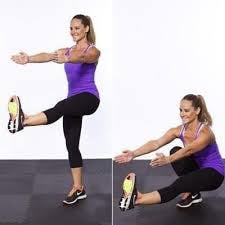
Life is not all about being on two feet all the time. Think about sports, are you on both feet all the time. Rarely! The majority of sports require running, sprinting, cutting, decelerating, hopping or jumping. This predominantly requires each leg to be able to perform independently of what the other leg is doing. This requires near perfect trunk control to be able to balance and coordinate the action of standing on one leg and allow full weight bearing through maximal range of motion. This is not a beginner exercise! Only those desiring maximal athletic performance and bulletproof joints should perform this exercise. As a prerequisite you should be able to perform all of the above squats with at least bodyweight as resistance prior to trying the pistol squat. If you have any known back, hip, knee, ankle or foot malady this squat is not for you. This squat should also be performed without resistance first to see if you own the balance, flexibility and control required. Then once you display competency external resistance can be added. The risk and reward for this squat should only be accepted for the extreme athlete therefore I am highly cautious in recommending this exercise unless I have observed your movement level.
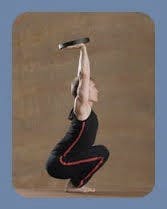

Are you serious? The candle squat as created and probably only able to be performed by Jerzy Gregorek. For those of you unaware of this man’s ability, I implore you to visit The Happy Body website where Jerzy outlines a baseline level of nutrition, flexibility, strength and stability that is unparalleled. If you were looking for the gold standard in squatting than this is platinum. This gentleman’s ability to move makes me absolutely jealous. A picture is worth a thousand words so I will stop writing. If you are even remotely close to possessing the ability to perform this squat then stop reading my blog as reading any further could only surely cause you some level of dysfunction and we wouldn’t want that.
Conclusion
To summate all that we have discussed in this three part series on the squat, I must confess that there is surely an awful lot that I have not discussed or by constraint omitted. The subject of squatting is vast and the breadth of information fills whole books. The important point that I wanted to convey over the past few months on this blog is the importance of correct daily squatting.
Just like your motor vehicle requires oil changes, tire air pressure checks and other routine maintenance your body requires daily squatting as maintenance for baseline musculoskeletal health. Your body requires other daily movement different than squatting to maintain its health as well. Dr. Kelly Starrett has come to the conclusion that 10 minutes a day in the deep squat is a good baseline. Proper daily squatting is similar to eating whole food for your nutrition and getting eight hours of sleep a night in terms of health for your body.
I encourage readers to educate themselves on their own performance by having your movement assessed by a professional. Having your movement assessed by a trained individual can be enlightening, eye opening and explain if you have been consistently injured or stuck in a rut with your performance. Please call our office and I will be glad to run you through a functional screen. Two people who possess near perfect movement ability and should therefore be emulated are Jerzy Gregorek, who was mentioned earlier, and Steve Cotter of IKFF and kettle bell fame. Both of these people can be found on YouTube and their websites on the internet. Here’s to your health, happy holidays and happy new year!




